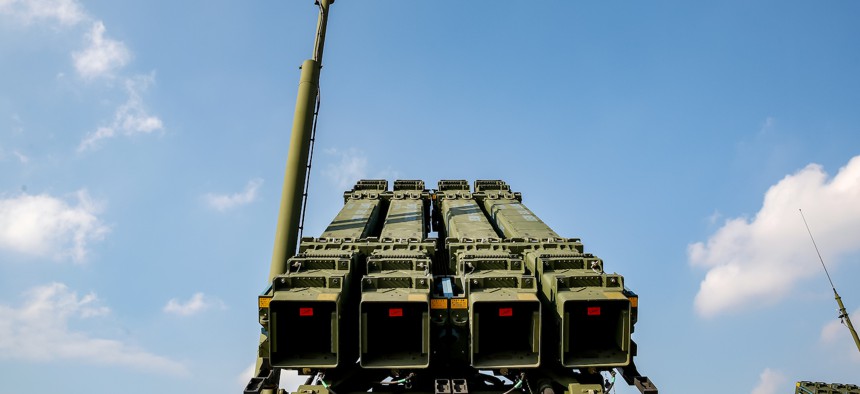
A Patriot air defense system Dominika Zarzycka / SOPA Images / LightRocket via Getty Images
Ukraine downed a hypersonic missile with a Patriot. What that says about the future of weapons
Weapons makers say the Pentagon has made progress on innovation, but still has work to do.
The Defense Department is finally learning some key lessons on innovation, getting away from big, expensive programs that produce overly sophisticated weapons and moving toward buying arms faster and more cheaply, representatives from Anduril, Saildrone, and Lockheed Martin told lawmakers Wednesday.
The department is also discovering how new software can increase the value of things it already has. But the Pentagon still has work to do in setting universal standards and prioritizing low-cost, modular-software-based approaches to making weapons, they said during a House Armed Services subcommittee hearing.
New software can can improve older systems, Lockheed CEO James Taiclet said, citing the Patriot missiles recently sent to Ukraine. In May, Ukrainian forces shocked the world when they used the Patriot—invented in the 1970s, upgraded many times since—to down a Russian hypersonic Kinzhal, a missile Putin had touted as “invincible”.
Taiclet said the shootdown shows how software upgrades can enable an existing system "to deal with a more advanced threat using software and advanced networking technologies before you can build a new hardware system.”
At a time when the United States is spending billions of dollars on new satellites to track highly maneuverable missiles, Ukraine’s Patriot shows that the Pentagon already has a hypersonic defense in a crude form, Taiclet said. “There'll be a cat-and-mouse game that will continue here, because the more sophisticated the maneuvering and the final terminal stage of the missile can go, the tougher it's going to be to hit. But we're actually in the cat-mouse game on hypersonic defense already. And I would say that is a significant deterrent.”
The executives were broadly enthusiastic about the Defense Department’s recently announced Replicator program to quickly produce thousands of low-cost drones for the air, land, and sea.
“Mass is going to be the determining quality that really matters. You know, the number of systems we can field and the rate we can replenish them. The volume we can get…pre-positioned and ready and demonstrate that we have that capacity is absolutely critical to creating deterrence” said Brian Schimpf, CEO and co-founder of Anduril.
But the Defense Department is still holding too many competitions in which companies present white papers with proposals instead of working prototypes to test, Schimpf said. And the Defense Department needs to write bigger checks early when it finds winners, he said.
What the department needs is “sustained and ruthless competition among serious bidders providing developed capabilities, not white paper submissions featuring familiar contestants and derivative wares. These competitions should be actual product-driven ‘bake-offs,’ and not paper-based evaluations. And they should end in a meaningful award.”
Taiclet said the Pentagon should move toward software standards so it’s not dealing with hundreds of different devices with wildly different frameworks.
“If there are 10,000 competitors…what are the interface technologies we're going to use? What's the error correction code that will let people share? We'll cross-license those to each other so that our investments, whether a small, medium, or large company, are compensated for and there's some return to our investors,” he said.
Taiclet noted that when the telecommunications industry converged on a single cellphone standard in the early 2000s, it allowed the industry to graduate from 3G to 4G to 5G in the amount of time it usually takes the Pentagon to design and build a new plane.
The United States must also look at rules governing where defense contractors can produce weapons so it can move some production to countries that are closer to adversaries, they said, highlighting the AUKUS agreement as a potential model.
But some of the executives’ recommendations also clearly served the interests of their companies. For instance, the idea that the Defense Department should move to a smaller set of software standards implicitly favors larger and more established players to write those standards.
Similarly, Taiclet suggested the Pentagon move away from asking companies to produce very specific systems according to strict requirements and instead look to companies to solve more broadly defined problems, which Taiclet described as “missions.”
“We have created institutional capability to map missions. So a mission would be ‘air superiority.’ ... DOD would say: ‘We are paying you to do X; give us air superiority here’ as opposed to, ‘Produce this system’…The way to accomplish this, in our view, is to create this mission roadmap, meaning: what are…the airplanes I already have today? What are the radar systems I have? What are the satellite sensors that could be looped into a mission to shoot down enemy airplanes before they can shoot you down?”
No matter its merits, the idea favors large, established prime contractors that can much more easily integrate their own planes, drones, and sensors. And, of course, the contractor would have a greater incentive to use their own products rather than incorporate those of competitors, which could lead to higher prices for U.S. taxpayers.
At one point during the hearing, Rep. Ro Khanna, D-Calif., brought up a June 60 Minutes report on price gouging by defense contractor, and asked Taiclet whether Lockheed Martin could accept a cap of 20 percent profit on a weapon it makes.
Taiclet declined the offer and suggested it is a conversation best had elsewhere.




